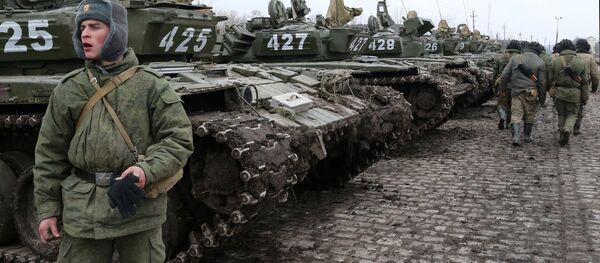A few years ago the Obama administration announced its plan to modernize the country's nuclear arsenal; the potentially dangerous initiative is paving the way for a new atomic arms race, according to Professor Gordon Adams of the American University and Richard Sokolsky of the Carnegie Endowment for International Peace.
"The United States is on the cusp of launching an unnecessary, expensive, and potentially dangerous plan to modernize its strategic nuclear forces, helping stimulate what is being called a 'new nuclear arms race.' The United States can deter any country from using nuclear weapons against America and its treaty allies with a nuclear force that is far smaller, less destabilizing, and less expensive than the one the Pentagon is planning to build," Adams and Sokolsky write in their article for DefenseOne.com.
"I state clearly and with conviction America's commitment to seek the peace and security of a world without nuclear weapons," the US President said in his official speech in Prague, Czech Republic on April 5, 2009.
However, contrary to all expectations, the Obama administration has announced its plans to modernize the US atomic stockpiles.
According to the program, the entire US nuclear arsenal, including the warheads, and the missiles, planes and submarines will be rebuilt.
The 30-year $1 trillion dollar plan proposes "to build 12 nuclear-armed submarines, 100 strategic bombers, about 400 land-based ballistic missiles, 1,000 cruise missiles, and hundreds of upgraded bombs and warheads to go with them," Washington DC-based Director of Policy at Ploughshares Fund Tom Z. Collina observes in his article for Foreign Policy.
"Consider the fact that the United States still has about 4,700 nuclear weapons in its stockpile… It's safe to say we've got far more nuclear weapons than we need," Collina stresses, branding Barack Obama's "overblown effort" as "dangerous."
Furthermore, delivering a speech to the Defense Writers Group on December 3, 2015, former Secretary of Defense William J. Perry stated clearly that Washington is "now at the precipice, maybe I should say the brink, of a new nuclear arms race."
At the same time the American scholars see no sense in Obama's nuclear initiative.
"The Obama administration's nuclear spending plans simply make no sense. It would be like Google investing a trillion dollars in typewriters," Collina believes, referring to the fact that nuclear arms are in fact "artifacts of bygone era."
Adams and Sokolsky deem that there is no need to waste US taxpayers' money on America's "bloated" nuclear arsenal.
Instead of bolstering the US' outdated atomic Triad, the Pentagon should retire the 500 land-based ICBMs and abolish plans to invest in a new long-range strategic bomber ("when the fleet of B-52s can operate effectively for at least another 20 years"), Adams and Sokolsky proposed, pointing to the fact that the move could free up to $60 billion over the next ten years.
These savings "could be applied to buying the forces appropriate to our real defense challenges," the US scholars emphasized, adding that the White House should start open negotiations with the Russians about a renewed effort to reduce the two largest strategic nuclear forces in the world.
The administration nuclear program "would keep strategic warheads within the New START limits, but at an unnecessarily high cost and with an increased risk of strategic instability," Adams and Sokolsky note.
The question remains open how Obama's successor will implement the present administration's controversial nuclear plan.




